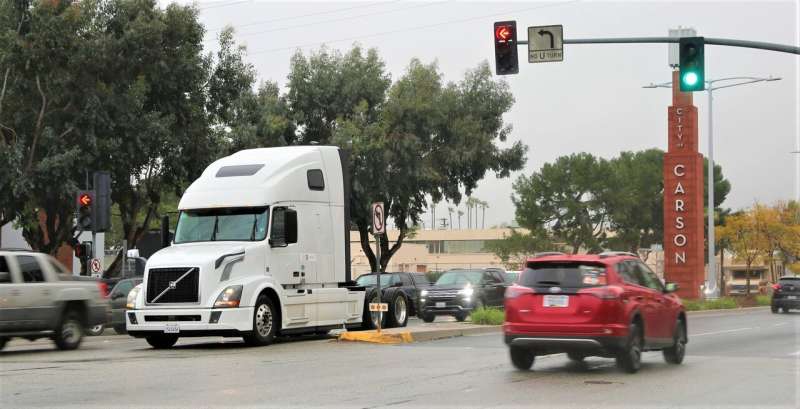August 22, 2019 feature
Testing a connected eco-driving system in field trials with heavy-duty trucks

Currently, 90 percent of fuel used for transportation is petroleum-based, making it one of the key contributors to air pollution worldwide. Recent technological advances, however, are finally enabling the development of new tools to reduce energy consumption and greenhouse gas (GHG) emissions associated with transportation.
One of the strategies that researchers have been exploring is connected eco-driving, which entails the use of connected and automated vehicle (CAV) technology. This technology can reduce the number of stops and idling time for individual vehicles, while also avoiding unnecessary acceleration or deceleration based on live traffic information, such as signal phase and timing (SPaT) data for individual traffic signals.
Despite the promise shown by some of these approaches, most studies have so far focused on testing connected eco-driving in passenger cars, showing fuel savings of around 10 to 15 percent. Implementing this strategy on heavy-duty trucks could lead to similar, if not greater, fuel savings.
Aware of this gap in the literature, a team of researchers at the University of California, Riverside (UC Riverside) and Volvo Group North America has recently tested a connected eco-driving system in a series of field trials with heavy-duty trucks. Their findings, presented in a paper pre-published on arXiv, are highly promising, with their system leading to significantly smoother speed profiles of trucks as they approach intersections.
"We have been working on this technology as part of our Connected and Automated Vehicle research program for a little over a decade now," Kanok Boriboonsomsin, the lead researcher, told TechXplore. "The main idea is that by enabling communication between vehicles and roadside infrastructure (i.e. traffic signals), we can improve the efficiency of driving, which will help to reduce vehicle fuel consumption and tailpipe emissions."
The system developed by Boriboonsomsin and his colleagues, called Eco-Drive, guides drivers as they approach and depart from signalized intersections based on real-time SPaT information. This can enhance energy efficiency and decrease GHG emissions by prompting vehicles on the road to follow carefully-designed speed profiles when approaching an intersection.
In their recent study, sponsored by the California Air Resources Board and the South Coast Air Quality Management District, Boriboonsomsin and his colleagues set out to test their eco-driving system in field trials on the roads of Carson, California, applying it to heavy-duty trucks that typically release high amounts of greenhouse gases. The trials were carried out along two corridors with six connected, signalized intersections, which were set up to communicate SPaT information to all vehicles equipped with the system.
"When the equipped vehicle approaches a connected traffic signal, the system receives information about when the traffic light will change," Boriboonsomsin explained. "It then uses that information along with others (i.e. how far the vehicle is from the traffic signal, current vehicle speed, whether there is another vehicle in front and how fast that vehicle is going, and speed limit of the road) to calculate and provide recommended driving speed to the driver."
The system proposed by the researchers essentially guides drivers through a given intersection when a traffic light is green or alerts them so they can prepare to stop if the light is turning red, avoiding unnecessary hard braking. This helps to improve fuel efficiency, reducing tailpipe emissions of individual vehicles.
"We are rigorously evaluating the benefits of the technology in terms of fuel consumption and emissions reduction in simulation," Boriboonsomsin said. "This allows us to control the various uncertainties in real-world traffic environment so that we can make an apples-to-apples comparison between driving with and without the system."
It took strong partnerships between stakeholders from both public and private sectors to enable Boriboonsomsin and his colleagues to test their connected eco-driving technology in real traffic environments. For instance, UC Riverside's collaboration with Volvo was a key enabler for the field tests.
"We worked with cities, municipalities, and equipment vendors to enable connectivity at selected signalized intersections," Boriboonsomsin said. "We also worked with Volvo Group to develop and implement the system on heavy-duty trucks. Without any of these elements, the field trials would not be possible."
The limited number of field trials carried out by the researchers have yielded very promising results, with equipped vehicles showing far smoother speed profiles while approaching intersections. Calculations using the U.S. Environmental Protection Agency's MOVES model suggest that their connected eco-driving system results in approximately 9 percent fuel savings in acceleration scenarios and 4 percent in deceleration ones.
"The immediate next step is to evaluate the benefits of the technology in terms of reductions in fuel consumption and emissions under a variety of scenarios, which we are currently doing," the researchers added. "Then, we plan to implement and test this technology on advanced technology vehicles such as plug-in hybrid electric trucks and battery electric trucks. The energy efficiency gain from the connected eco-driving system can help extend the range of these trucks. In addition, we hope to integrate the connected eco-driving system with automated driving technology to make the vehicle follow the recommended speed automatically."
More information: Early findings from field trials of heavy-duty truck connected eco-driving system. arXiv:1908.00541 [eess.SY]. arxiv.org/abs/1908.00541
© 2019 Science X Network



















